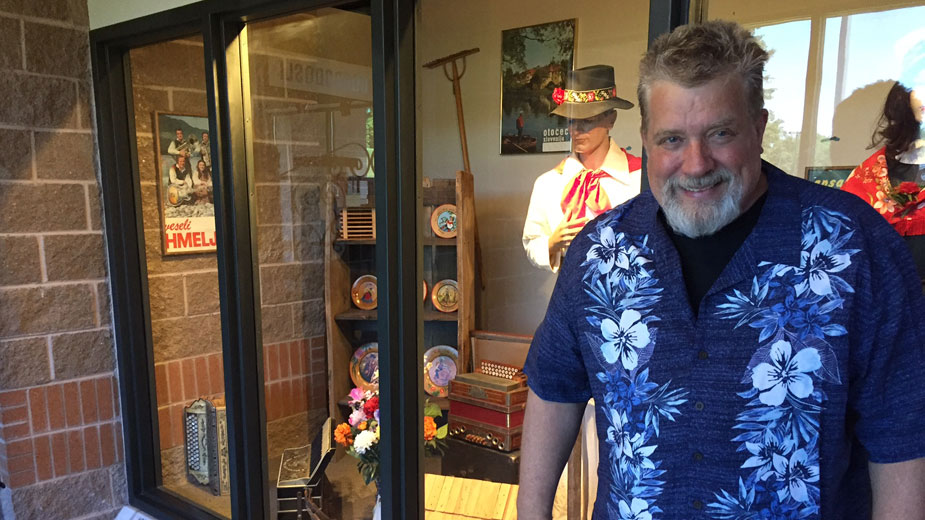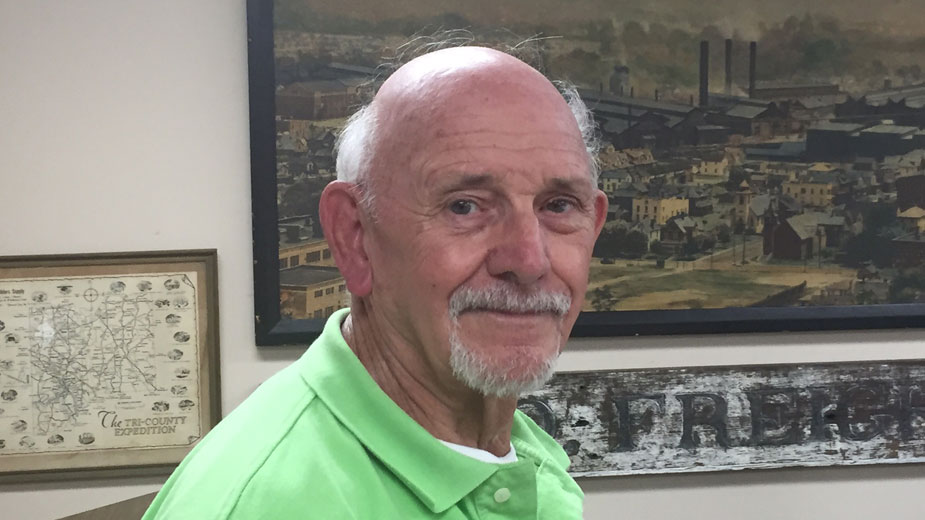Small Towns Reveal Character, Culture of Lawrence County
LAWRENCE COUNTY, Pa. – There’s not much left in the heart of the small borough of Wampum, Pennsylvania, except its heart – its big heart.
A good number of storefronts sit empty along Main Street in this town of about 700 people, sandwiched between state Route 18 and the west bank of the Beaver River in southern Lawrence County. A local restaurant recently closed its doors, while a small fitness center still operates out of a building that dates to the turn of the 20th century.
But in the center of town, a small sign affixed to the glass door of the local Stop & Shop Food Mart speaks to the character of this tight-knit community: “Hungry? No Money? You Are Welcome. Free Meal.”
“Several years ago, this business came up for sale and we bought it,” explains Lori Arafa, who along with her husband Jim, own the small store. “It was the right thing to do.”
The sign on the door is her husband’s idea, and he is the one that manages the shop most of the week, Arafa says. “He’s extremely generous.”
The couple lives in New Castle, but thought the Wampum community provided a special opportunity after closing their video store business.
“People are so nice here,” Arafa says. “Everyone knows everyone and they were very welcoming.”
When the restaurant next door closed, the Stop & Shop began serving pizza, opened a deli counter, and fired up a grill that serves wings and hamburgers for lunch, Arafa says. “My husband has also started cooking some breakfast.”
Like most of this region, small towns such as Wampum were hit hard with the retrenchment of the steel industry during the late 1970s and early 1980s. Many of the residents were employed in the steel industry when work was plentiful. Nearby towns such as Ellwood City and Koppel were once home to a diversified industrial base, which helped lift the prospects of the county’s smaller boroughs.
Still, smaller communities have proven resilient in the face of daunting odds.
A community park anchors the north end of Wampum, along with Universal Refractories Corp. the town’s major manufacturer. On the north end of Main Street, a gazebo and historical marker acknowledges the significance of the borough. Founded in 1796, it is the oldest settlement in Lawrence County and is named for the Native American term that Europeans interpreted as “money.”
Arafa says he isn’t sure whether development of Royal Dutch Shell’s $6 billion ethane cracker – about 10 miles directly south near Monaca, Pa. along the Ohio River – would have any impact on the small borough. The project should employ as many as 6,000 contractors and tradesmen during the construction phase and more than 500 permanent jobs when it’s operational.
“I don’t know if it could help, it’s hard to say,” she says. “It would be great.”
Still, such a major investment is bound to have some effect to this part of Lawrence County, observes Everett Bleakney Jr., president of the Ellwood City Historical Society. “It might make a difference in terms of housing,” he says, but suspects that the overall business impact on the community would be minimal.
Ellwood City was established in 1892 after Henry Waters Hartman and a group of other investors purchased land and plotted the town that would accommodate a rail line stretching from Pittsburgh to Chicago, Bleakney says. The advent of rail traffic opened up a whole new sales pitch for the town – instead of developing heavy manufacturing, the idea was to market Ellwood City as a resort area that was free from the smog and soot of industrial centers such as Pittsburgh, New Castle and Youngstown.
It worked for a period of time, Bleakney says. The city’s amusement park – Rock Point Park – drew thousands of people from northeastern Ohio and western Pennsylvania via rail lines heading into Ellwood City.
“The railroads would bring them in,” he says. “However, once the automobile took hold, other options availed themselves, such as Idora Park in Youngstown and Kennywood Park in Pittsburgh.” The use of the automobile enabled motorists to drive to parks in closer proximity, and Rock Point fell into disrepair.
Along with tourists, however, Ellwood City attracted industry and immigrants, especially from Italy, Bleakney says. “Down the street was the Bank of Italia,” he gestures. “Stone masons working here would send money back to Italy.”
Among the notables who were born in Ellwood City is Lewis Robert “Hack” Wilson, who still holds a Major League record for most RBIs in a single season with 191, Bleakney says. “He set that record in 1930 with the Chicago Cubs and it still stands,” he says. The closest any other player has come to touching that statistic was Lou Gehrig with 184 and Hank Greenberg with 183.
Moreover, Wilson held the National League record of most home runs in a single season – 56 – before being eclipsed by the Cubs’ Sammy Sosa in 1998. Mark McGuire of the St. Louis Cardinals would eventually win the home run duel that year with 70, an all-time Major League record.
Through the years, most residents worked in the steel industry, anchored by the presence of U.S. Steel Corp.’s seamless tube mill, Bleakney says. Before U.S. Steel established its plant, Ralph Stiefel, an investor from England who saw the potential of the American market, introduced the first seamless tube manufactured in the United States from a plant built here, he notes.
One of the city’s largest employers is still Ellwood City Forge, today part of the Ellwood Group, whose headquarters remain in the city, Bleakney says.
In 1950, the city’s population crested just above 15,000. “We’re now at about 7,000,” Bleakney says.
Preservation of heritage and culture is the goal of SNPJ, the smallest borough in Lawrence County and one of the smallest in Pennsylvania.
The borough encompasses 500 acres, and was incorporated in 1977 to accommodate development of a recreational area formed by the Slovenska Naronda Podporna Jednota, or SNPJ, which translates in English as the Slovenian National Benefit Society.
“SNPJ is a fraternal life insurance company,” says Tim Jergel, director of the recreation area. “They built this as a summer camp for about 40,000 members throughout the country. They wanted the Slovenian people to have a place to enjoy.”
During the 1950s and 1960s, the bulk of the Slovenian population in the United States was concentrated in Pittsburgh and the Cleveland areas, Jergel says. It made sense to stake out an area that sat relatively equidistant between the two metropolitan areas.
Land was acquired along state Route 108 in North Beaver Township, just east of the Ohio border. Members broke ground on the community in 1965 and it was completed in 1967, Jergel says. Additional development was necessary, and to accomplish that, SNPJ applied for and received borough status from the state.
“We incorporated in 1977 – partially because North Beaver Township was dry and we wanted to serve alcohol,” Jergel says. “Mainly though, it was to control our own development here inside the grounds. It’s enabled us to improve our buildings, our facility and our infrastructure,” he says.
These improvements included cabins, a lake, pavilions, a heritage center, a banquet facility, bocce courts, a pool and tennis courts. There is also a 115-pad area for trailers. “We have 60 cabins on about 500 acres,” he says.
The 2010 census found that SNPJ had a population of 18, most of whom spent the winter in Florida.
In 2001, the grounds underwent a major renovation, and as a nod to the cultural importance of the area, Milan Kucan, then the president of Slovenia, was on hand for the ribbon-cutting.
Jergel says the objective is to keep the Slovenian culture and heritage relevant.“The music, dance, food and heritage – we’re trying to keep it alive here,” he says. “Not too many young people are listening to polka.”
 Tim Jergel welcomes visitors to SNPJ, a tiny borough dedicated to Slovenian culture.
Tim Jergel welcomes visitors to SNPJ, a tiny borough dedicated to Slovenian culture.
SNPJ hosted its annual Brew and Bean Fest in May, and will host a wine and sausage festival in September. A small vineyard was planted in 2013 and is used to make homemade wine each year, Jergel notes.
Tapping into the wine business has helped the tourist trade in other small communities across the county, especially in Volant, in the northeastern portion of the county.
“We’re getting a bigger pull from the cities, which is good,” says Tiffany Jackson, manager at Knockin’ Noggin’ Cidery and Winery. The business sells wine made in Pulaski, Pa. and was established in Volant in 2015.
“The foot traffic is good,” she says. “It’s picked up in summer, but even the winter and spring were good.”
Other vendors in Volant observe that the small community is adding more variety to the small shops that had dominated the town in the past.
“I love it here,” says Barbara Ord, owner of The Showroom, a women’s boutique. “I’ve been here since November.”
Since then, she’s witnessed several businesses move in, including a bookstore and antiques shop. “It looks like there’s more variety such as art, furniture and homemade goods. There’s just an old-world charm to it all.”
Pictured: Everett Bleakney Jr. says Ellwood City was plotted by investors to accommodate rail traffic.
Copyright 2024 The Business Journal, Youngstown, Ohio.



